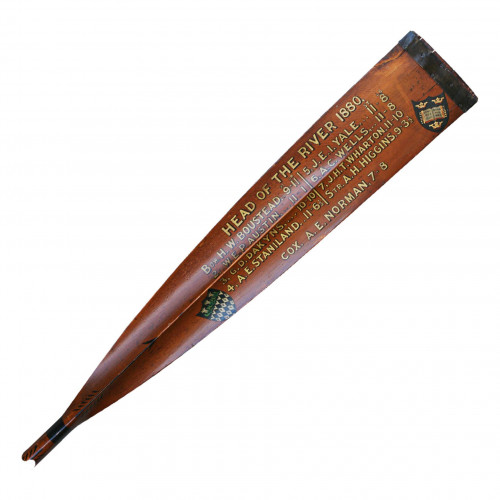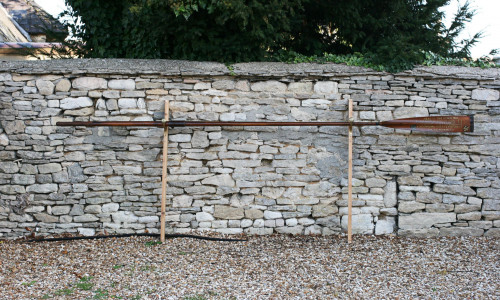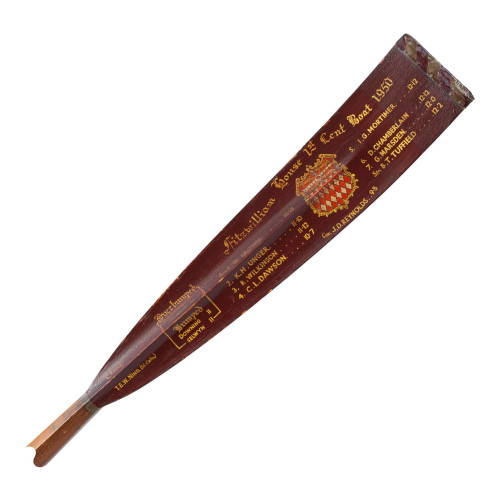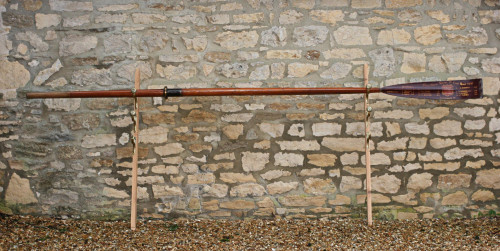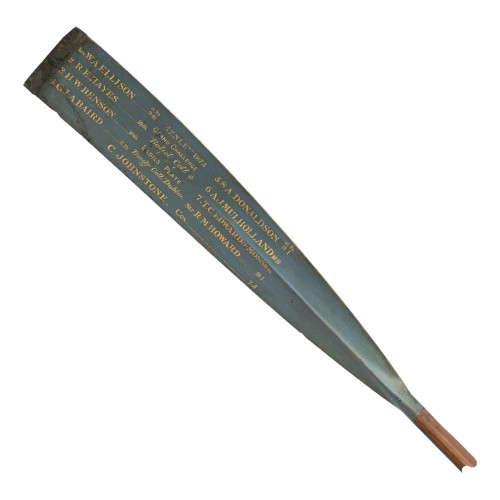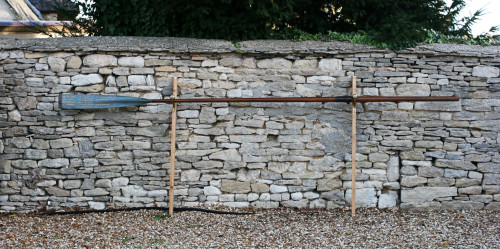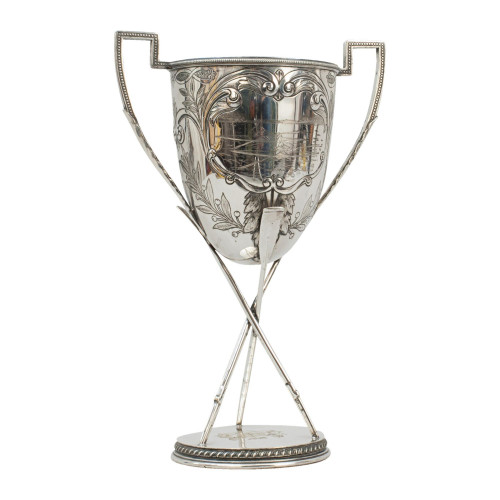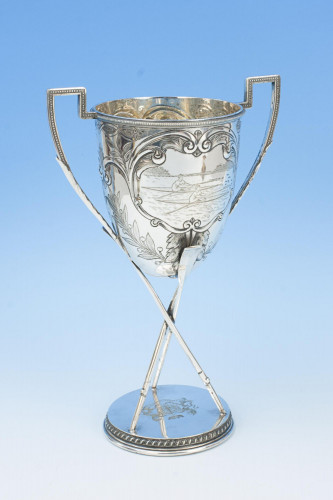- Home
- Rowing & Yachting
- 12' Presentation Rowing Oar Trophy, Oxford University, 1897 Balliol
12' Presentation Rowing Oar Trophy, Oxford University, 1897 Balliol
12' Presentation Rowing Oar Trophy, Oxford University, 1897 Balliol
30302
Antique Rowing Oar, 1897 Balliol College Oxford, 2nd Torpid.
The full-length oar is an original traditional presentation rowing oar with gilt calligraphy and Balliol college insignias. It is a beautiful oar and in original condition. The calligraphy denotes the crew's names and weights with the oar being No.7 denoting it belonged to W. Mitchell - Thomson. Most probably William Lowson Mitchell-Thomson, 1st Baron Selsdon KBE PC (15 April 1877 - 24 December 1938), known as Sir William Mitchell-Thomson, 2nd Baronet. We also have two other oars once belonging to Mitchell - Thomson, Head of the River - Torpid 1899 & Head of the River - Torpid 1898.
The calligraphy on this blade reads:-
Balliol College 2nd Torpid 1897
Six Bumps - Wadham - Oriel - Jesus - CH CH II - Keble - Pembroke
Bow G.H. Moorhead 9st. 13lbs
2. M. Irving 10.9¼
3. E.H. Pelham 11.7
4. E.J. Skinner 11.8
5. H.W. Hallifax 12.7
6. C.U. Wills 11.5½
7. W. Mitchell - Thomson 12.2
Str. J.L. Coolidge 10.13
Cox. ???????araj Singh 8st.10lbs
As the oar is full length (12 foot) shipping can be quite expensive. We have come up with an ingenious way to cut the oar so as to make shipping cheaper, the oar can then be easily reassembled. One of the images shows different images of an oar that has been cut down. It is cut by the leather sleeve so the joint is less visible or obvious. The oar can then be bolted together to make the oar one solid piece.
Please do enquire about the different shipping options.
Any crew which records four consecutive bumps is said to have 'gained their oars'. The prize being a full-size oar decorated with the names of the full crew in gold lettering on the college colours for each rower. The cox is given a decorated rudder and the coach receives a decorated wooden shield with a mock-up of the bow end of a boat.
Both Oxford and Cambridge Universities host two university bumps races yearly, each lasting several days. The races are for eights (i.e. eight rowers and a cox), each representing one of the university's various colleges. One of the races is held in early spring and the other in early summer, in Oxford they are called 'Torpids' in the spring and 'Eights' in the summer, in Cambridge these are called 'Lent Bumps' and 'May Bumps'. The leading crews of the Lent Bumps go on to race the leading Oxford Torpids crews at the Henley Boat Races around Easter.
The first attested bumps race took place in Oxford in 1815 and was between two eights from Brasenose College and Jesus College. Twelve years later Lent Bumps racing commenced at Cambridge University. As the Isis and Cam are long narrow rivers, not ideal for normal side by side racing, Bumps racing evolved. The competing crews line up bow-to-stern in order, one behind the other with gaps of about 1½ boat lengths between them. The start of the race commences with the firing of a cannon, the idea to progress up their division by attempting to catch and Bump (touch) the boat in front whilst simultaneously trying not to be Bumped by the boat behind. The ultimate aim becoming top of the first division and "Head Of The River". When a bump has taken place both of the crews involved in the Bump pull over to the river bank and take no further part in that race, allowing the rest of the division to pass. The only difference is in Torpids where the crew whose boat was Bumped has to continue racing (and is liable to be bumped again). It is possible to "over bump", if the 2 crews involved in the Bump have pulled over and the crew behind them manage to catch the boat that was in front of them, this is an "over bump".
William Lowson Mitchell-Thomson, 1st Baron Selsdon KBE PC (15 April 1877 - 24 December 1938) was a Scottish politician who served as British Postmaster-General from 1924-1929, during which time the BBC came into existence as a Corporation. He chaired the Television Committee of 1934-5 and its successor Television Advisory Committee (1935-1940) until his death in 1938.
Early life
Mitchell-Thomson was born at 7 Carlton Terrace, Edinburgh, the son of Mitchell Mitchell-Thomson, Lord Provost of Edinburgh (1897-1900), who was created a baronet in 1900.
He was educated at Winchester College and Balliol College, Oxford. He earned his LL.B with distinction from the University of Edinburgh in 1902 and joined the Scottish bar that same year, but spent several years travelling. He was engaged for a time in West India business. He travelled extensively in many parts of the world, including Siberia, Manchuria, and Korea, before returning to Scotland.
Political career
He was elected as a Unionist Member of Parliament for North West Lanarkshire in 1906, becoming prominent among the young Unionists and proving himself as an astute examiner at question time while in the Opposition, serving until his defeat at the January 1910 general election.
Described once as "the best looking man in the House of Commons", he had black, wavy hair, and was clean shaven, with a prominent chin and bold forehead. According to one writer, he was a favourite choice as a platform speaker for his party when it was known that women electors would predominate among the audience.
He was an Irish Unionist Party MP for North Down from April 1910 until 1918.
During the First World War he held the rank of Hon. Lieutenant in the Royal Naval Volunteer Reserve. He served as Director of Restriction of Enemy Supplies. He was appointed a Commander of the Order of the British Empire in the 1918 New Year Honours.
Following the War, he was appointed the British representative on the Supreme Economic Council followed by appointments as Parliamentary Secretary to the Ministry of Food and at the Board of Trade.
He was then MP for Glasgow Maryhill between 1918 and 1922, then Conservative MP for Croydon South, South London from 1923 to 1932.
Thus, he had the distinction of representing, in turn, Scottish, Irish, and English constituencies.
Postmaster General
In 1922, Mitchell-Thomson was Parliamentary Secretary to the Board of Trade.
As Postmaster-General from 1924 until 1929, he proved an energetic and capable minister. Postal reforms were instituted, and the telephone service was materially improved, extended, and modernised. He came in for criticism, however, by refusing on a number of occasions to receive deputations.
During the General Strike in May 1926 be held the position of Chief Civil Commissioner. His part, as he himself afterwards described it, was "to organise the machine to secure that the will of the majority of the people should prevail".
Having played such an important part in the development of the BBC, Mitchell-Thompson's name was subsequently mentioned twice in connection with key posts at the BBC. The first occasion was as successor to Viscount Bridgeman, who died in 1935 while Chairman of the Board of Governors. He was also considered a likely candidate for the position of Director- General vacated by Sir John Reith in June 1938.
Peerage and honours
In 1932, he resigned from the House of Commons and was raised to the peerage, taking the title of his last constituency, Baron Selsdon of Croydon in the county of Surrey.
He was also KBE, CBE, a member of the legion of Honour, a recipient of the Order of the Crown of Italy, and a member of His Majesty's Bodyguard in Scotland, Royal Company of Archers.
Television Advisory Committees
He was Chairman of the Television Advisory Committee which was formed in 1934 and reported in January 1935.
Personal life
In 1909 he married Madeleine, the daughter of the late Sir Malcolm McEacharn, of Galloway House, Garlieston, Wigtownshire, and his heir, the Hon. Patrick Mitchell-Thomson, was born in 1913. The Hon. Patrick married in 1936 Phoebette, daughter of Mr Crossley Swithinbank, of Donnington Grove, Newbury.
Lord Selsdon's first marriage was dissolved in 1932, and in 1933 he married Effie Lilian Loder Johnson, daughter of Lieutenant-Colonel Charles Brennan, of Mullingar, Ireland, who, as Miss Effie Cook, was once a member of Pellissier's 'Follies'.
Death
William Mitchell-Thompson became suddenly ill on Christmas Eve and died the same night. He was aged 61. At his bedside was his only son, the Hon Patrick Mitchell-Thomson.
Taken from Scotland On Air
Dimensions:
1850-1899
1897
Pine
United Kingdom
Calligraphy is a little faded, the blade tip with historical cracks and repair, handle end has been cut down a fraction.
Thank you for your enquiry.
We will get back to you soon.
Please create wishlist to add this item to
RELATED ITEMS























